AMD A10-7800 Review: Testing the A10 65W Kaveri
by Ian Cutress on July 31, 2014 8:00 AM EST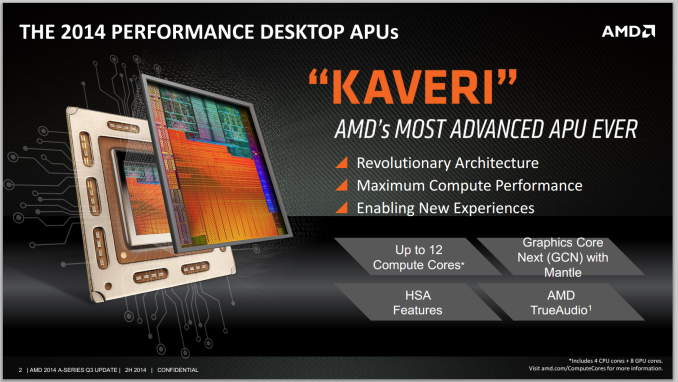
AMD A10-7800 Review: Testing the A10 65W Kaveri
Kaveri was launched as a processor line, on desktop, back in January 2014. At the time we were given information on three of the APUs, the A10-7850K, A10-7700K and A8-7600, and reviewed two of them, including the A8-7600 65W processor. However, at the time, AMD stated that the model we tested was to come out at a later date: that date is today, in a trio of 65W parts. The A10-7800 we are testing today is the locked down version of the A10-7850K, with a slight speed reduction to hit 65W as well as a configurable TDP to 45W.
The Drive to Lower TDP
Previous AMD APU releases have often come with a flurry of processors up and down the price range. Back with the Llano cores and the FM1 platform, two processors were released in the first month followed by six the next and six more by the end of the 2011. With Trinity, it was a similar story: four processors in the first two months, then ten more by the end of the 2012. Richland had eight processors at launch, then other 8 by the end of 2013 and three more for 2014. This is what makes Kaveri a little different: two 95W processors at launch at the start of 2014, and three 65W for July 2014, six months later. Not only is this a large time gap between expanding the processor range, but also a small number of SKUs. That being said, CPU-World lists another 65W APU for release after this trio, and then no more Kaveri until the end of the year when four ‘PRO’ (aka ‘Business Class’) models enter the arena.
Having your mainstream platform headed up by two 95W APUs of the latest generation architecture for so long does nothing for the low power crowd, and AMD’s official reasons for delaying the launch of their 65W parts is due to the lower power message AMD wants to convey, especially in terms of configurable TDP.
Each of the new 65W parts released today has two modes of operation. Out of the box, they will run in 65W mode, using a restricted range of processor frequency in the faster end of operation but with ultimately less efficiency. With an adjustment in the BIOS, they will operate at 45W, which will adjust the base frequency of the processor, relying more on turbo for single threaded workloads. AMD’s numbers above quote a 6-7% dip in performance for a 31% drop in TDP.
If we consider Intel's strategy and AMD's older strategy into the mix, CPU manufacturers would release two processors, one at 45W and one at 65W, in order to offer this difference. That way each die could be tuned for frequency or voltage, as well as processor graphics residency. For whatever reason, AMD decided to consolidate the differing power options, perhaps in order to reduce the number of SKUs on the shelves and make the customer’s choice an easier one.
But therein lies an issue. The number of users prepared to go into the BIOS and adjust the frequency is slim at best, which leads on to system integrators to implement this change in the units they sell. But which system integrators are going to sell products to their customers that do not perform at the maximum performance? It only works when the APU is for a specific design, like an off-the-shelf HTPC or digital signage. The other implementation could be that in order to make the product stack work, it helps to have a few SKUs such that everyone pays more even if they use less – having 45W APUs in the stack might drive sales away from the higher performing models.
The New APUs
AMD’s nomenclature on Compute Cores sums up the number of CPU threads and the number of Compute Units in the processor graphics to give a total number. The previous APUs released were rated at 12 compute cores (A10-7850K) and 10 compute cores (A10-7700K), and the new APUs released today have 12 (A10-7800), 10 (A8-7600) and 6 (A6-7400).
| AMD Kaveri APUs | |||||
| A10-7850K | A10-7800 | A10-7700K | A8-7600 | A6-7400K | |
| TDP | 95W | 65W | 95W | 65W | 65W |
| Compute Cores |
4 CPU + 8 GPU |
4 CPU + 8 GPU |
4 CPU + 6 GPU |
4 CPU + 6 GPU |
2 CPU + 4 GPU |
| Modules / Threads | 2 / 4 | 2 / 4 | 2 / 4 | 2 / 4 | 1 / 2 |
| Base Frequency | 3700 | 3500 | 3400 | 3100 | 3500 |
| Turbo Frequency | 4000 | 3900 | 3800 | 3800 | 3900 |
| L1 Cache |
192 KB I$ 64 KB D$ |
192 KB I$ 64 KB D$ |
192 KB I$ 64 KB D$ |
192 KB I$ 64 KB D$ |
96 KB I$ 32 KB D$ |
| L2 Cache | 4 MB | 4 MB | 4 MB | 4 MB | 1 MB |
| Graphics | R7 | R7 | R7 | R7 | R5 |
| GPU Cores | 512 | 512 | 384 | 384 | 256 |
| GPU Clock | 720 | 720 | 720 | 720 | 756 |
| Max DDR3 | 2133 | 2133 | 2133 | 2133 | 1866 |
| SSRP | $173 | $155 | $155 | $105 | $77 |
One might imagine that AMD would at some point offer APUs at the same frequency with the same name but without the ‘K’ monitor for overclocking, but the distinct numbering difference is occompanied by the respective frequency adjustments. In this case, the A10-7800 is 200 MHz less on the base frequency than the A10-7850K but +100 MHz over the A10-7700K.
AMD confirmed with us after the initial press call the number of streaming processors in the processor graphics, as well as their frequencies. Based on these numbers, the two 78xx APUs have the full complement at 720 MHz, with the 77xx and 76xx reducing down to 6 compute cores. The A6-7400K is interesting in that the frequency is increased to 756 MHz, perhaps indicating that removing one of the CPU modules and half the IGP gives them extra room to play with for frequency. The A6 model does have another metric to set it apart – official memory support is down to DDR3-1866. This differentiation was also present on the Richland 65W A6 and Trinity 65W A6 processors as well.
| AMD 65W Bulldozer Based APUs | ||||||||
| Trinity | Richland | Kaveri | ||||||
| Model |
A6- 5400K |
A8- 5500 |
A10- 5700 |
A8- 6500 |
A10- 6700 |
A10- 7800 |
A8- 7600 |
A6- 7400K |
| Microarchitecture | Piledriver | Steamroller | ||||||
| Socket | FM2 | FM2+ | ||||||
|
Modules / Threads |
1 / 2 | 2 / 4 | 1 / 2 | |||||
| CPU Base Freq | 3600 | 3200 | 3400 | 3500 | 3700 | 3500 | 3100 | 3500 |
| Max Turbo | 3800 | 3700 | 4000 | 4100 | 4300 | 3900 | 3800 | 3900 |
| TDP | 65W | |||||||
| L1 C$ | 64/32 |
128 KB C$ 64 KB D$ |
192 KB C$ 64 KB D$ |
96/32 | ||||
| L2 C$ | 1 MB | 2 x 2 MB | 1 MB | |||||
| Graphics |
HD 7540D |
HD 7560D |
HD 7660D |
HD 8570D |
HD 8670D |
R7 | R7 | R5 |
| GPU Cores | 192 | 256 | 384 | 256 | 384 | 512 | 384 | 256 |
| GPU Clock | 760 | 760 | 760 | 800 | 844 | 720 | 720 | 756 |
| Max DDR3 | 1866 | 1866 | 1866 | 1866 | 1866 | 2133 | 2133 | 1866 |
| Current Price | $60 | $99 | N/A | $119 | N/A | $155 | $105 | $77 |
Kaveri APU Features
In our initial Kaveri coverage and review of the A10-7850K, AMD spent a large amount of time with the press going over their new features for the Kaveri line of APUs. At the time, Mantle support was the big headline, along with HSA (Heterogeneuous System Architecture) that afforded several compute features which could accelerate certain workloads.
Rahul’s deep dive on HSA is well worth a read, beyond my simple coverage here. The main principles allow the processor threads and integrated graphics to both access the same areas of DRAM (known as a Unified Memory Architecture) without expensive memory copies and maintaining the data structure.
With heterogeneous queuing, both the CPU threads and integrated graphics can generate extra work for the other, allowing for dynamic asynchronous compute.
These features, along with working with software developers to optimize their workflow, allow AMD to quote improvements. In our PR pack with this launch AMD is quoting up to 69% faster upscaling in Adobe Photoshop CC for A10 vs. i5, up to 7x faster in LibreOffice for A8 vs. i3, and up to 65% faster JPEG decoding time on A6 vs. Pentium.
For gaming, alongside Mantle support due to the use of GCN, AMD has also implemented the TrueAudio DSP on the Kaveri APU line. Rather than use CPU power or shaders for complex directional audio affects, the DSP is designed to speed these up and reduce stress on other components of the system for better frame rates. The two games being quoted for TrueAudio are Thief and Lichdom Battlemage.
The other feature using the GCN cores is HEVC Compute support with PowerDVD 14, using OpenCL to speed up decoding for high definition content. With a soon-to-be released update, AMD Fluid Motion Video should also be supported.
Launch Deal
With the launch of the 65W APUs, AMD is going to run a promotion for any user purchasing an A10 between August and October – purchase an A10 APU and have a choice of a free game between Thief, Sniper Elite III and Murdered Soul Suspect.
Test Setup
As these APUs are still part of the Kaveri line, they should work with any FM2+ motherboard, although depending on the motherboard manufacturer it may require a BIOS update. We suggest that you contact the retailer to ensure that the motherboard BIOS is up to date and compatible with the new APU.
| Test Setup | |
| Processor |
AMD A10-7800 2 Modules, 4 Threads |
| Motherboards | MSI A88X-G45 Gaming |
| Cooling |
Corsair H80i Thermalright TRUE Copper |
| Power Supply | OCZ 1250W Gold ZX Series |
| Memory | 2 x Corsair Vengeance Pro 2x8 GB DDR3-2400 10-12-12 Kit |
| Memory Settings | 2133 8-9-9 |
| Video Cards | MSI GTX 770 Lightning 2GB (1150/1202 Boost) |
| Video Drivers |
Catalyst 14.3 NVIDIA Drivers 337 |
| Hard Drive | OCZ Vertex 3 256GB |
| Optical Drive | LG GH22NS50 |
| Case | Open Test Bed |
| Operating System | Windows 7 64-bit SP1 |
| USB 2/3 Testing | OCZ Vertex 3 240GB with SATA->USB Adaptor |
| WiFi Testing | D-Link DIR-865L 802.11ac Dual Band Router |


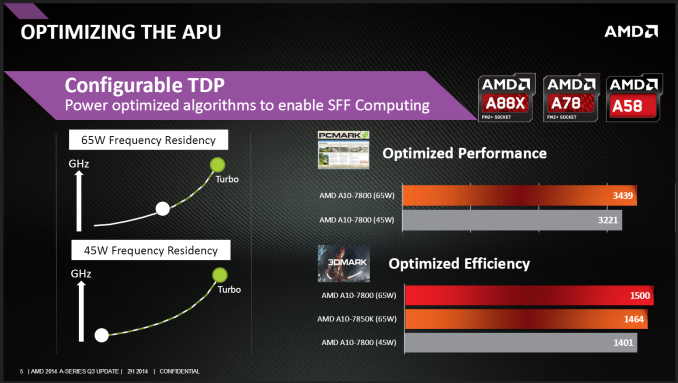
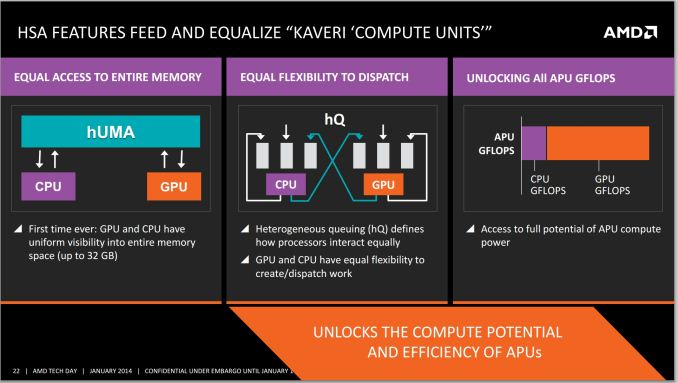
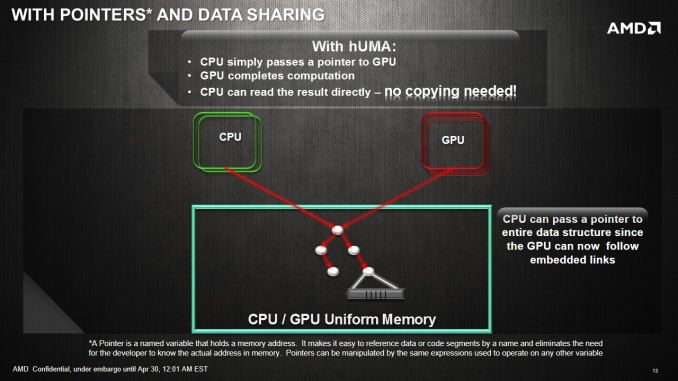
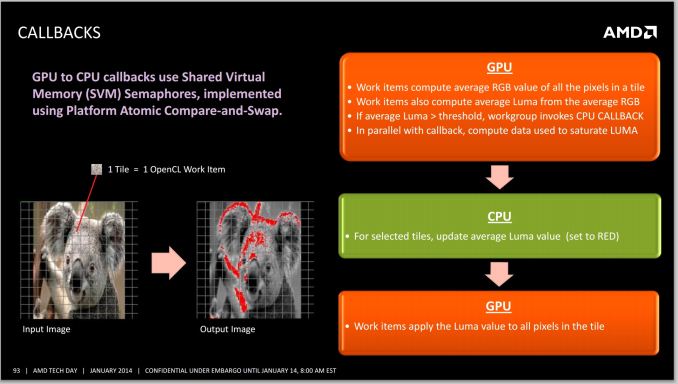






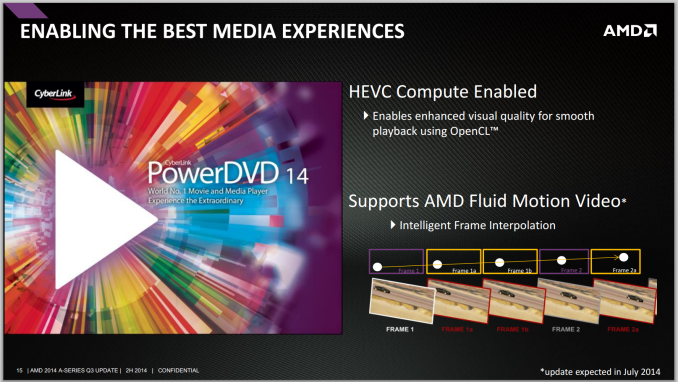









147 Comments
View All Comments
austinsguitar - Thursday, July 31, 2014 - link
just for shiz and giggles.... how about qualcomm start making desktop grade equipment. they need to! intel now has a total monopoly right now. cmon qualcomm come at me!jamescox - Thursday, July 31, 2014 - link
Enthusiast make cpu performance to be much more important than it actually is. For most everyday use (web surfing, web video, etc) there isn't going to be too much subjective difference between any modern cpus. For gaming, the cpu is also becoming mostly irrelevant. If you play at 1080p or greater with a dedicated gpu, you have to go down to a very low-end cpu before it will make much of any difference. This may change when DX12 comes out, since they are supposed to be making it more multi-threaded. This may favor cpus with 4 or more threads eventually, but one should not buy computer hardware based on "eventually". I wouldn't even bother overclocking a cpu for gaming these days. I would consider water cooled gpus and such for a high-end gaming machine though.AMD is presumable working on stacking memory chips in with their gpus and apus, but this will be a ways off and may be limited to mid-range or higher. Any added step in processing adds the possibility of failure of the final package, which increases cost. It seems like they could achieve near dedicated gpu performance with an integrated memory chip similar to iris pro, but perhaps this is too expensive. It also may cannibalize dedicated gpu market. Intel doesn't have that concern since they have no dedicated gpu market.
I have also wondered why they don't put a gpu-like memory interface on these apus and just solder everything onto the board. This would deliver dGPU like performance and would be great for mobile and SFF; it would be very similar to what is in the PS4. It would have low cpu performance due to power limitations, but not that many applications actually require more cpu performance these days.
AMD has more gpu power available on-die, so they need to add something like Intel's quick sync or other software/hardware features. The APUs should not lose in video encoding and such when they have more processing resources available. Is the OpenCL accelerated version of handbrake available yet? Several of the applications under cpu benchmarks can be gpu accelerated, and several of them that cannot be gpu accelerated are probably not really relevant. Any of these chips are fast enough for web browsing. I am still using an old core2duo laptop for web browsing, and it mostly works fine. The memory size (<4 GB) seems to be more of a limitation than the cpu speed.
MrVeedo - Thursday, July 31, 2014 - link
these chips serve their purpose in my opinion. amd does seem to get a lot of bashing, some deserved I will admit, but again it all depends on what you will be doing with your pc. if you shop around, you can pick up a nice board and cpu for relatively cheap. my most recent build is focused around the asrock fm2+ itx motherboard and a 7850k. using a fractal node 304 case, I have 6 hard drives and a 250gb msata ssd, along with a xonar stx sound card. my killawatt meter is in front of me and its reading a 44 watt draw while typing this. obviously the drives are asleep at the moment. the cpu is clocked at 4.1, gpu 960, mem speed at 2133. just to give an idea on power consumption.Cerb - Sunday, August 3, 2014 - link
With HP and Lenovo both using AMD APUs in mainstream notebooks, including HP in their business lines, clearly they are doing something right with the latest APUs, even outside of our bubble (like having good enough real-world performance per dollar and Watt).Cerb - Sunday, August 3, 2014 - link
I get CPU-limited in games a few years old, don't even have a >=1080p monitor, and AMD doesn't even produce a CPU as fast as mine. "Gaming," is quite varied in terms of performance. AAA shooters, and most games also on consoles, will not need much CPU, because even the latest consoles are running Atom-class CPUs (the prior gen would get laughed at by current Atoms). Games tuned for each platform, or just on PCs, tend to be much more CPU heavy, or at least capable of being so (usually resulting in what amounts to a different game).Cerb - Sunday, August 3, 2014 - link
Re more processing: they don't have more CPU processing resources than Intel's CPUs. If Handbrake intends to maintain quality over speed, FI, don't expect much gain from any GPU acceleration. GPU accel works well for some video processing, and depending on program used, can make a big difference in speed of editing videos, but not so much encoding. The image viewer is all I saw that definitely should be able to be accelerated by the GPU, though the 3D particle bench might be able to be. The rest are very much cases for CPUs, not at all GPUs. Not that there isn't a lot that can be accelerated, but of the chosen things to test, there's not much there that would be a good case for it.nofumble62 - Thursday, July 31, 2014 - link
AMD finally could produce a credible alternative for Intel Celeron.Cerb - Sunday, August 3, 2014 - link
That's a bit low. I'd take a Vishera or Kaveri over a Celeron any day, as a current daily user of a Haswell Celeron. If you were used to a 4MB/die or 6MB/die Core 2, or a Phenom II w/ L3, or better, a new brand Celeron would be a palpable step backwards, while most of AMD's APUs are quite capable, and only feel slow when faced with long-running CPU-limited tasks.wintermute000 - Friday, August 1, 2014 - link
a.) Lack of power test results is worrying.b.) Why are the gaming benchmarks done @ 1280x1024? Why not do 1368x768 and 1680x1050 and 1920x1080? i.e. the resolutions of most monitors
Aside from that, looks grim for AMD, absolutely no point to these APUs - even if the power usage is indeed efficient, we're looking @ desktop not laptop chips. The only scenario I can see them being useful is in tiny HTPC/mITX builds where you're not using a dGPU. Otherwise as many have commented, a pentium + dGPU will smoke kaveri at not much extra cost. AMD better pray that OpenCL takes off in a big big way.
Personally, I would love a ~50-80 dollar version with just a minimal IGP and ECC support for low power file server / virt platform.... intel cores are expensive :)
Anonymous Blowhard - Friday, August 1, 2014 - link
Um, you do know that the G3220 supports ECC RAM, right?